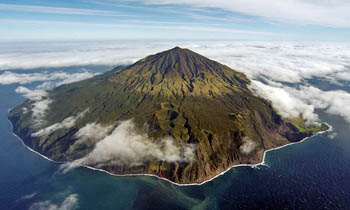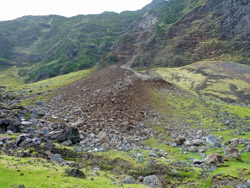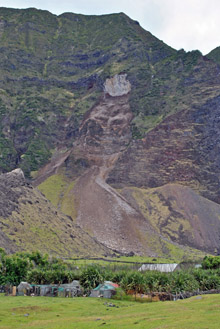Landslides
 |
The Tristan da Cunha composite volcano is made up of alternate layers of volcanic ash and lava, with many intrusions interspersed. The ash is exceptionally unstable, easily eroded and when exposed by marine erosion forms ideal conditions for mass movement of rocks, characterised by frequent landslides on the exposed cliffs which fringe the entire island. So landslides are commonplace and smaller rock falls an almost daily occurrence and Tristan da Cunha is not for rock climbers! |
|
This page will catalogue significant mass movements as they occur. |
|
landslide behind the 1961 volcanic cone in February 2011
Report from Geologist Anna Hicks
 |
Photo from Anna Hicks left shows the landslide scar above and debris below taken from alongside the west side of the 1961 volcanic cone. |
Photo above from Sean Burns shows the view of the scar above and debris fan beneath from the village. |
| The main rockfall occurred at about 3.45am on Tuesday 1st February (there had been some precursory falls earlier, according to islanders). Following a night of heavy rain and thunderstorms, the fall came crashing down as large blocks and scree, which landed at the base of the cliff on both sides of the volcano. The fall originated from a lava flow about 2/3 of the way up the cliff (roughly 350/400m) and left a scar in the flow about 30/30m wide. Debris has continued to fall up to 10th February. The Settlement has not received any rainfall since the 1st so it is probable that another storm will dislodge further blocks and move some of the fallen blocks further down the gulch and the back fence. | ||
| Just a few weeks before the rockfall, a new access road to the volcano had been cut, which was suitable and safer for tourists. The old access road, which went behind the volcano, has now been covered by the fall. | ||

